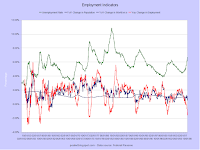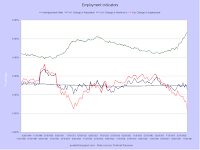The numbers were awful:
- 533K lost in November (initial estimate)
- 403K lost in October revised from 240K
- 320K lost in September revised from 284K
- Total YoY loss of 1,870K
Time to nationalize the banks. There are too many holes to plug.
Update: Chart Pr0n!
 Here are the raw numbers for population, civilian non-institutional population (adult non-convicts and non-military), labor force (everybody who wants to work according the BLS's questionable standards), employment (people who are working in some manner), manufacturing payroll, and government employees (federal, state, and local civilian workers). The numbers run from January 1952 to November 2008.
Here are the raw numbers for population, civilian non-institutional population (adult non-convicts and non-military), labor force (everybody who wants to work according the BLS's questionable standards), employment (people who are working in some manner), manufacturing payroll, and government employees (federal, state, and local civilian workers). The numbers run from January 1952 to November 2008.
 The non-institutional population has gone up over the past half century due to the "Boomers" growing up...err, getting older. The labor force has expanded due to the "Boomers" and to women entering the workplace. Government employment has grown as well, but not as much as manufacturing has declined. The rest of the employed are part of the glorious "service economy", parts of which have been dedicated to impoverishing the nation for the past 10 years. The slim bit of yellow are people who have been liberated from their jobs.
The non-institutional population has gone up over the past half century due to the "Boomers" growing up...err, getting older. The labor force has expanded due to the "Boomers" and to women entering the workplace. Government employment has grown as well, but not as much as manufacturing has declined. The rest of the employed are part of the glorious "service economy", parts of which have been dedicated to impoverishing the nation for the past 10 years. The slim bit of yellow are people who have been liberated from their jobs.
 Zooming in on employment doesn't reveal much more. A non-zero based graph right here would be more dramatic, but misleading.
Zooming in on employment doesn't reveal much more. A non-zero based graph right here would be more dramatic, but misleading.
 Graphing the percentage changes of employment and workforce shows an interesting correlation between the two. The unemployment rate line shows that job recovery has become less rapid, perhaps due to the decline of large manufacturing plants, or to better inventory management. Note that the unemployment rate equivalent to the "U3" number from the BLS.
Graphing the percentage changes of employment and workforce shows an interesting correlation between the two. The unemployment rate line shows that job recovery has become less rapid, perhaps due to the decline of large manufacturing plants, or to better inventory management. Note that the unemployment rate equivalent to the "U3" number from the BLS.
 The correlation is much clearer when the timeframe is narrowed. I'm going to march boldly out onto a limb and state there is a causal relationship from job growth to workforce growth. The BLS gets accused of fudging the U3 number it publishes because the highly variable workforce number makes the U3 look better.
The correlation is much clearer when the timeframe is narrowed. I'm going to march boldly out onto a limb and state there is a causal relationship from job growth to workforce growth. The BLS gets accused of fudging the U3 number it publishes because the highly variable workforce number makes the U3 look better.
 Over the long term, the ratio of workers to non-workers is very important. It's gone up until recently.
Over the long term, the ratio of workers to non-workers is very important. It's gone up until recently.






No comments:
Post a Comment